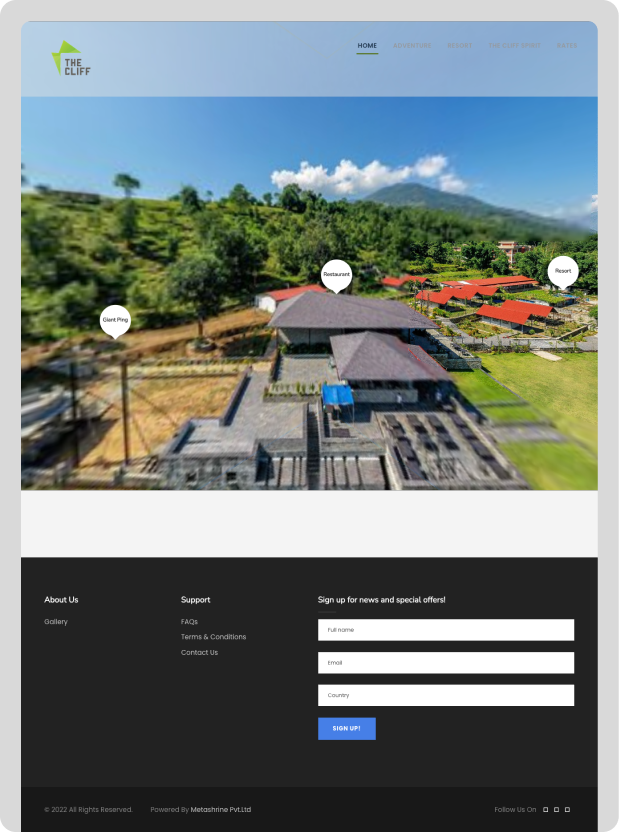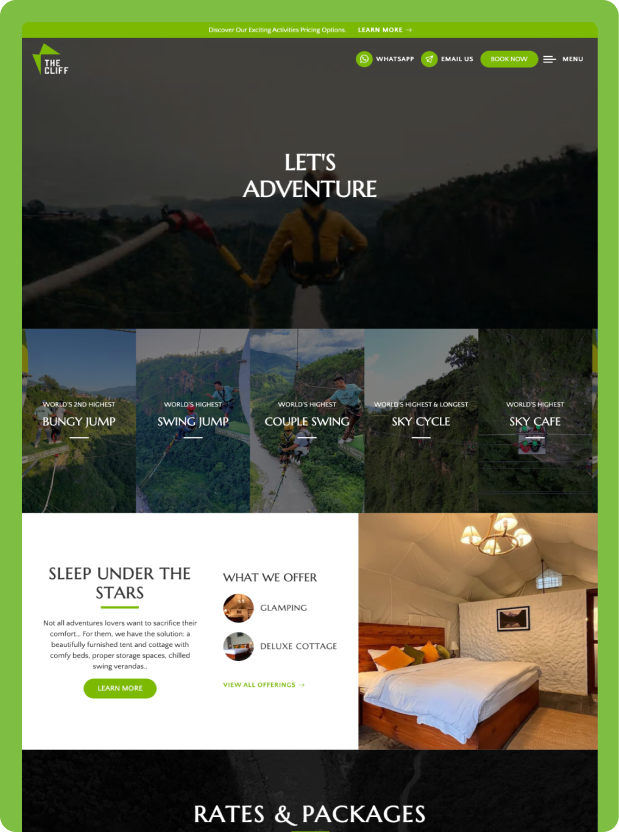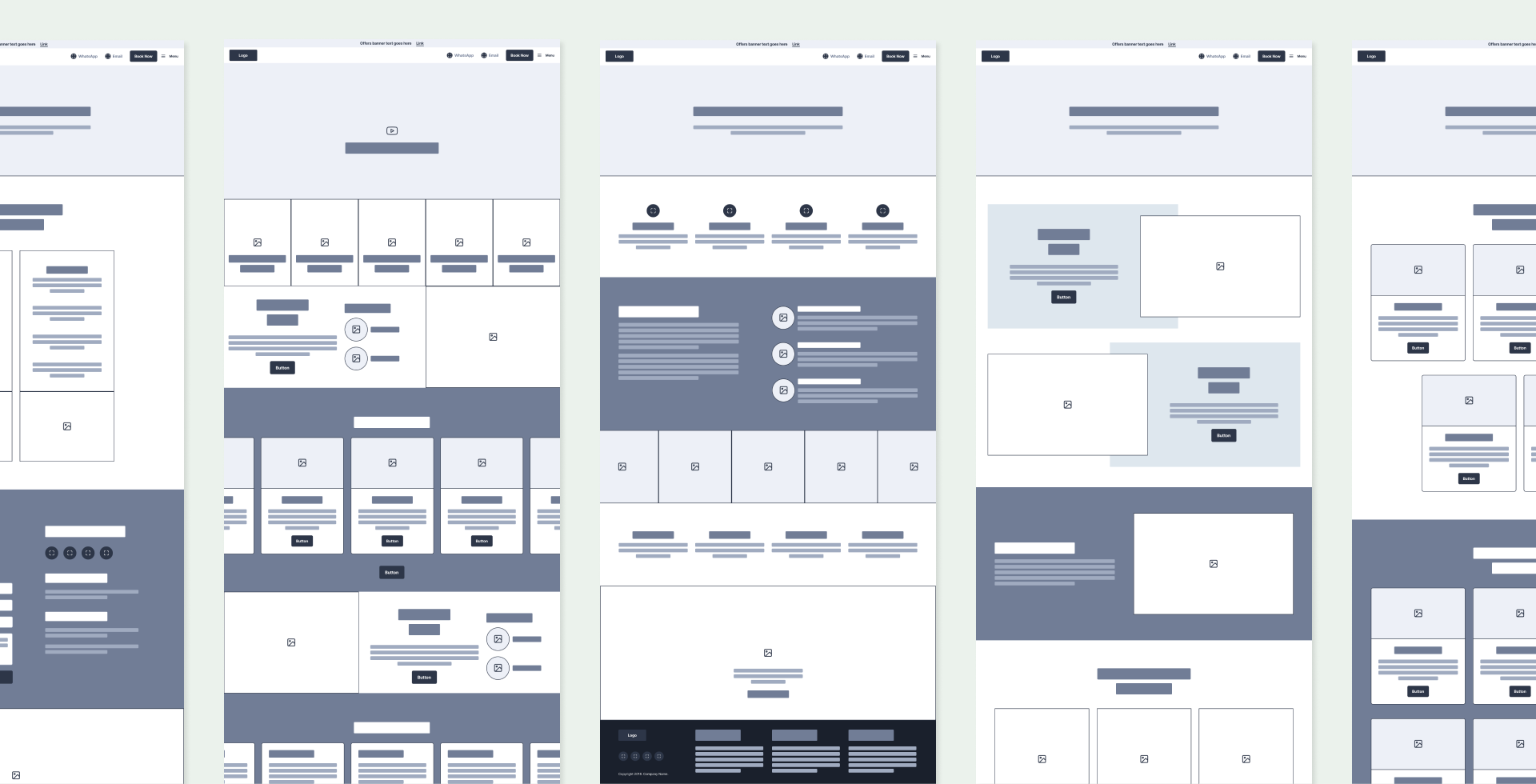Travel, Tourism 
Elevating Adventure Tourism: Designing a Breathtaking Digital Experience for The Cliff Nepal

Travel, Tourism 

About the Project
The Cliff Nepal is an adventure tourism company located in Kushma, Nepal, known for hosting the world's second-highest bungee jump, they attract thrill-seekers and adventure enthusiasts from around the globe. The client sought a comprehensive redesign of their website to better capture the thrilling experience they offer, enhance user engagement, and drive more bookings. The ultimate objective was to create a modern, user-friendly website that would enhance The Cliff Nepal's online presence and drive business growth.
View Live WebsiteAgency
Source Taggers
Year
2023
Roles
Research & Discovery
Wireframing
Prototyping
UI/UX Design
Web Design
HTML & CSS Developer
Tools
Figma
Trello
Adobe CC
Illustrator
Photoshop


01. Start
The Cliff Nepal faced several challenges with its previous website design. The outdated aesthetic failed to capture the thrilling and adventurous spirit of the destination, potentially deterring visitors seeking an exhilarating experience. Poor user experience (UX) issues, such as complicated navigation and a cumbersome booking process, led to high drop-off rates and low conversion levels. Ineffective brand communication meant the website did not effectively convey The Cliff Nepal's unique selling points and safety measures, hindering its ability to stand out in the competitive adventure tourism market. Additionally, the lack of mobile responsiveness limited accessibility and usability for users accessing the site on smartphones and tablets.
Addressing these challenges was crucial for The Cliff Nepal to enhance its online presence and effectively communicate its brand identity to visitors.
To address the challenges, I redesigned the website with a contemporary aesthetic that captures the thrill and adventure of The Cliff Nepal. This included incorporating high-quality images and videos to showcase the breathtaking experiences and natural beauty, creating an engaging visual experience for visitors. To enhance user experience (UX), I simplified the navigation, streamlined the booking process, and implemented clear calls-to-action within an intuitive layout. Additionally, I developed a compelling narrative and refreshed the content to effectively communicate The Cliff Nepal's unique selling points, such as its status as the world's second-highest bungee jump and the comprehensive safety measures. Moreover, I adopted a mobile-first design approach, ensuring full responsiveness across various devices and screen sizes.
These solutions collectively enhanced The Cliff Nepal's online presence, improved user engagement, and effectively communicated its brand identity, positioning it as a top adventure tourism destination.
02. Research
The "Research & Discovery" process involved a comprehensive exploration of The Cliff Nepal's brand identity, market dynamics, and user preferences. Through in-depth interviews, market analysis, and user surveys, we gained valuable insights into the client's core values, unique offerings, and long-term goals. Analyzing competitor websites helped identify industry trends and opportunities for differentiation, while user feedback provided crucial insights into pain points and preferences. This thorough research formed the foundation for strategic decision-making throughout the project, guiding the design process to create a website that resonates with the target audience, effectively communicates the brand's unique selling points, and ultimately drives business growth for The Cliff Nepal.
The research and discovery phase began with an in-depth understanding of The Cliff Nepal’s brand, its offerings, and its long-term vision. We conducted extensive interviews with the client to grasp their values, unique selling points, and the specific experiences they wanted to highlight. This included a detailed exploration of the adventure activities, particularly the world-renowned bungee jump, and the rigorous safety measures that ensure a secure yet thrilling experience.
We analyzed the websites of both direct and indirect competitors in the adventure tourism sector. This competitive analysis helped identify industry standards, successful strategies, and common pitfalls. By understanding the strengths and weaknesses of competitors, we could pinpoint opportunities for The Cliff Nepal to stand out.
Defining the target audience was a critical step. We focused on thrill-seekers, adventure enthusiasts, and tourists aged 18-45 from both domestic and international markets. We also considered secondary audiences such as travel bloggers, influencers, and families looking for unique vacation experiences. By gaining a deeper understanding of their motivations, interests, and pain points, we could create a more compelling and relevant user experience.
Through surveys, interviews, and usability testing, we collected valuable feedback from past visitors and potential customers. This qualitative and quantitative data provided insights into user preferences, pain points, and expectations when interacting with adventure tourism websites. These insights informed design decisions and prioritized features to enhance user experience and drive engagement on The Cliff Nepal's website.
Users expressed frustration with the previous website's navigation, finding it difficult to locate information about activities, safety measures, and booking options. Simplifying navigation and streamlining the booking process emerged as crucial improvements to enhance user experience and encourage conversions.
Feedback emphasized the importance of visual content in shaping perceptions of the adventure experiences offered by The Cliff Nepal. Users responded positively to high-quality images and videos showcasing the breathtaking scenery and adrenaline-pumping activities.
Mobile users encountered significant usability issues on the previous website, including slow loading times, unresponsive elements, and poor readability. With the increasing prevalence of mobile devices for browsing and booking travel experiences, addressing mobile usability emerged as a priority.
Users expressed concerns about safety when considering adventure activities such as bungee jumping and zip-lining. Clear and comprehensive communication of safety measures, equipment standards, and operational procedures was deemed crucial for building trust and confidence among potential visitors.

Marketing Executive
GOALS: Emma loves thrilling adventures during her vacations and wants clear info to plan them easily.
FRUSTRATIONS: Confusing websites with unclear navigation and booking processes.
NEEDS: Emma needs a user-friendly website with easy booking and clear activity details.

Accountant
GOALS: John wants a safe and fun family vacation with clear safety info.
FRUSTRATIONS: Websites lacking safety details and are hard to use on mobile.
NEEDS: John needs a website with clear safety measures and mobile-friendly booking for stress-free planning.
03. Design Process
I created low-fidelity wireframes to outline the basic structure and layout of the website, focusing on key pages such as the homepage, activity details, and booking process.

The Global Design System for The Cliff Nepal's website served as a cohesive framework to ensure consistency and coherence across all design elements. This system encompassed various components such as typography, color palette, and visual elements, which collectively contributed to the overall look and feel of the website.

The visual design of The Cliff Nepal's website aimed to create an engaging and immersive experience that reflects the thrilling adventure and stunning beauty of the destination. This was achieved through a thoughtful blend of high-quality imagery, a cohesive color palette, intuitive layout, and compelling visual elements.
04. Conclusion
My journey through this project provided some valuable insights.
Focusing on user needs and feedback improved usability and user satisfaction. Regular testing and user insights were crucial in shaping the design to meet real user needs.
Providing clear and accessible information, especially about safety and activities, built user trust. Users engaged more with a website that offered well-organized and concise information.
Ensuring the website worked well on mobile devices was crucial. A mobile-first design approach improved the experience for the many users accessing the site on their phones.
High-quality images and videos significantly boosted user engagement. Investing in professional visuals helped attract and retain users, showcasing The Cliff Nepal's offerings effectively.